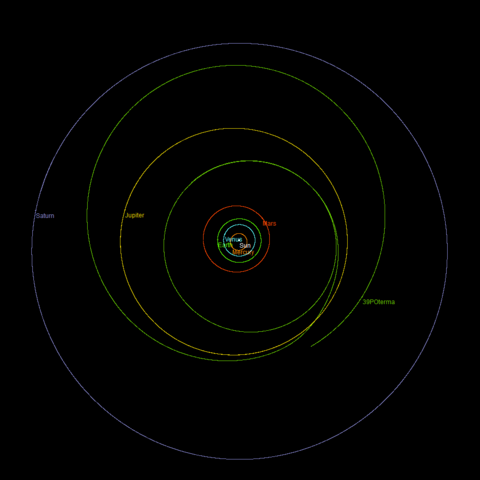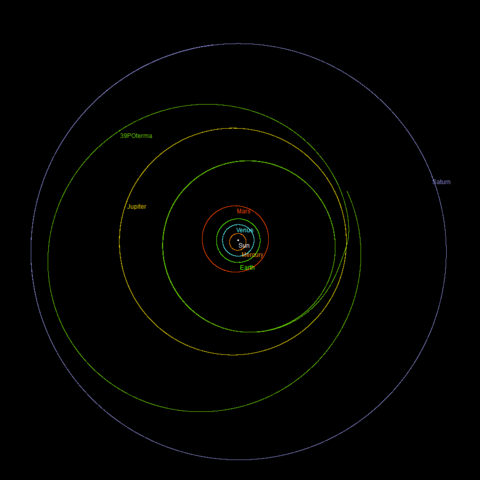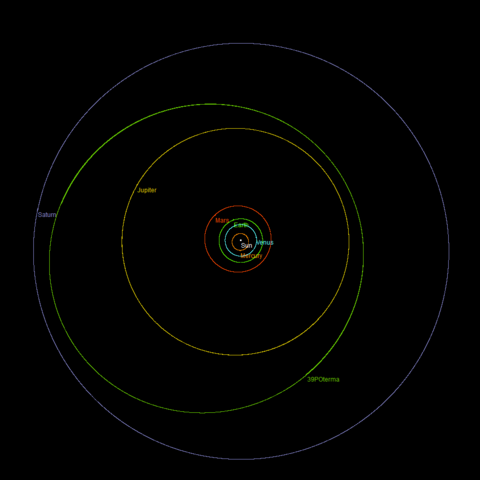39P/Oterma
| Discovery | |
|---|---|
| Discovered by | Liisi Oterma |
| Discovery date | 8 April 1943 |
| Designations | |
| 1942 VII; 1950 III; 1958 IV; 39P/2001 P3 | |
| Orbital characteristics | |
| Epoch | 2003 Jan 1.0 |
| Aphelion | 9.013 AU |
| Perihelion | 5.471 AU |
| Semi-major axis | 7.242 AU |
| Eccentricity | 0.245 |
| Orbital period | 19.49 a |
| Inclination | 1.943° |
| Last perihelion | 22 December 2002[1][2] |
| Next perihelion | 11 July 2023[1][2] |
39P/Oterma is a currently inactive periodic comet in our solar system with an orbital period of nearly 20 years. The size of its nucleus is not known.
Discovery
The comet was discovered by Liisi Oterma at Turku University Observatory, Finland on a photo plate on 8 April 1943 as a faint object of 15th magnitude in the constellation of Virgo. Its orbit was calculated by L. E. Cunningham and R. N. Thomas who derived an orbit with a small eccentricity, a perihelion distance of 3.4 AU (i.e. a little outside the main asteroid belt) and an orbital period of 7.9 years.[3]
The comet was continuously observed till after its next perihelia of 1950 and 1958, however a close approach (0.095 AU/14.2 Mio. km) to Jupiter on 12 April 1963[4] put it on its current inactive centaur orbit where it will not become much brighter than 22nd magnitude for a long while. Nevertheless it was recovered on 13 August 2001 on CCD images taken with the University of Hawaii 2.2 m reflector at Mauna Kea.[5]

Orbit
Comet 39P/Oterma has currently a centaur-like orbit with a perihelion greater than Jupiter and a semi-major axis less than Saturn. The eccentricity of its orbit is moderate and its inclination is only a little slanted with respect to the ecliptic. Because of this kind of orbit it cannot approach the sun closely and is therefore an inactive comet. It is classified as a Chiron-type comet with TJupiter > 3; a > aJupiter.[6]
Orbital Development
Comet 39P/Oterma is an object with a rather instable orbit in the long run because at irregular time intervals it undergoes very close approaches to the giant planets Jupiter and Saturn that severely influence and alter its orbit. This is also the reason why no definite statements can be made concerning the long-time development of its orbital characteristics for a period of more than a couple of hundred years in the past or in the future.
Apart from relatively precise statements for a few hundred years around our epoch, further conclusions can only be drawn by the use of statistical methods. By means of the software SOLEX 11.0[7] by A. Vitagliano and based on the values of the currently best known orbital elements of 39P/Oterma and their uncertainties from the JPL Small Body Database[6], a set of 400 clones of the “mean” comet with randomly Gaussian distributed orbital elements (using their mean values and their sigma-values) was created and the orbital development of this bundle of objects with nearly identical orbits at the start epoch was calculated back in the past and forth in the future (neglecting non-gravitational effects). The result of these statistical calculations is presented in the following paragraphs.
Not much can be said about the orbit of 39P/Oterma before the 19th century. It could have been anywhere either inside the orbit of Jupiter (least probable), between the orbits of Jupiter and Saturn (most probable), or even a Saturn-crossing one. Anyhow, even if it hadn’t been there before, with a probability of 20 % a close encounter (< 2 AU) with Jupiter happened between 1815 and 1817 which brought the orbit of 39P/Oterma for a longer period in a defined orbit. Thus at least from the beginning of the 19th century till 1937 the comet’s orbit was framed by Saturn’s orbit on the outside and Jupiter’s orbit in the inside. That means, 39P/Oterma was at this period a centaur-like object as it is today with no chance of being observed from Earth.
Following a closer approach to Jupiter (1.44 AU/215.6 Mio. km) on 27 March 1903, however, the comet’s orbit was slightly perturbed so that its next approach to Jupiter on 27 October 1937 became an extremely close one like it probably had not happened for many centuries before. On this day, the comet approached Jupiter to only 0.165 AU/24.7 Mio km and this had very peculiar consequences.
-
Before 1930, the orbit of 39P/Oterma was situated between the orbits of Jupiter and Saturn
-
The orbit of 39P/Oterma between 1920 and 1950 shows the transition from a centaur-like orbit into a quasi-Hilda orbit
Already since the beginning of 1935, the comet was moving in an orbit nearly identical to Jupiter’s with nearly the same angular velocity as the giant planet, i.e. 39P/Oterma underwent a temporary satellite capture (TSC) by Jupiter. However, this comet flew through the region near Jupiter over a rather short time, during which the comet did not complete a full revolution orbiting about the planet, instead already in the beginning of 1939 the comet could escape the planet’s attraction.
However, the close encounter with Jupiter had altered the comet’s orbital parameters severely. The semi-major axis was reduced from 6.9 to 4.0 AU, as the aphelion distance decreased from 8.0 to 4.5 AU, and the perihelion distance from 5.8 to 3.4 AU. Consequently, the comet’s orbit had become transformed from a centaur-like orbit to one that completely lay inside the orbit of Jupiter. As the comet was now much closer to the sun, it became active and its increased brightness combined with a closer distance from Earth gave rise to its discovery in 1943, five months after having passed its perihelion.
-
The orbit of 39P/ between 1945 and 1983 shows the transition from a quasi-Hilda orbit back to a centaur-like orbit
-
After 1980, the orbit of 39P/Oterma is situated again between the orbits of Jupiter and Saturn
As the revolution period was reduced from a little more than 18 years to 7.9 years, it was now in an exact 3:2 mean motion resonance with Jupiter. Such a Jupiter-family comet is called a “quasi-Hilda comet” (QHC)[8] and consequently after three revolutions the comet met again with the planet. From mid-1961 till the end of 1965 the comet again went through a temporary satellite capture (TSC) by Jupiter, while on 12 April 1963 an even closer approach to the planet at a distance of only 0.095 AU/14.2 Mio km occurred.

This lead again to a transformation of the comet’s orbit to an inactive centaur orbit with semi-major axis 7.2 AU, eccentricity 0.24, aphelion distance 9.0 AU, and perihelion distance 5.5 AU. The period of revolution became increased to 19.5 years. This is the current situation.
And this will remain alike for quite a while. Although a couple of closer approaches to Saturn (1.015 AU on 3 June 2011 and 1.93 AU around 1 October 2168) and Jupiter (0.889 AU on 15 January 2025, 0.771 AU on 21 February 2155, and 1.17 ± 0.03 AU in May-July 2214) are going to happen, the orbit of 39P/Oterma keeps its overall characteristics at least until the beginning of the 24th century: The semi-major axis will stay in the span of 7.0 to 7.8 AU, with the perihelion distance slowly increasing to 6.1 AU while the aphelion distance stays in the range of 8.1 to 9.4 AU, i.e. the orbit is again framed by Saturn’s orbit on the outside and Jupiter’s orbit in the inside. The period of revolution is always between 18.3 and 21.7 years.
However, this situation is going to change subsequently to a close encounter with Saturn during the second half of the year 2312 (0.8 ± 0.1 AU). This will bring the comet’s perihelion distance (reduced to 5.58 AU in 2400) in precarious vicinity to Jupiter’s orbit, which will lead to a very close encounter with Jupiter between mid-2428 and the end of 2431. With a probability of 35 % this approach will be closer than 1 AU sometime in 2429, but it could be even as close as 0.15 AU/22.3 Mio km.
The currently known data about the comet 39P/Oterma do not permit to extrapolate its fate with sufficient certainty beyond this Jupiter rendezvous because shortly after, the comet’s orbital parameters will be severely altered in a wide possible range. Only probabilities can be given.
Only 10 years after the encounter with Jupiter, the comet can be found with a probability of 11.5 % inside the orbit of Jupiter as a “quasi-Hilda comet“ (which would reactivate it to become more easily observed again from Earth). There is even a (very small) probability that the comet gets caught by Jupiter in a satellite capture, but more likely the comet will remain an inactive centaur-like object. A larger probability of 63 % sees it continuing in an orbit between Jupiter and Saturn, but there is also a probability of 25 % that the comet will become a Saturn-crosser. The orbital eccentricity may be distributed in a wide range from 0.03 to 0.44, while the inclination may be anywhere between 1.6° and 8.5°.
References
- ^ a b Seiichi Yoshida (2004-02-21). "39P/Oterma". Seiichi Yoshida's Comet Catalog. Retrieved 2010-02-24.
- ^ a b Syuichi Nakano (2001-08-24). "39P/Oterma (NK 810)". OAA Computing and Minor Planet Sections. Retrieved 2010-02-24.
- ^ Kronk, Gary W. (2001–2005). "39P/Oterma". Retrieved 2014-04-28. (Cometography Home Page)
- ^ "JPL Close-Approach Data: 39P/Oterma". 2001-09-19 last obs. used. Retrieved 2014-04-28.
{{cite web}}: Check date values in:|date=(help) - ^ "Minor Planet Center MPEC 2001-Q35 : COMET 39P/2001 P3 (OTERMA)". Retrieved 2014-04-28.
- ^ a b "JPL Small-Body Database Browser: 39P/Oterma". 2001-09-19 last obs. used. Retrieved 2014-04-28.
{{cite web}}: Check date values in:|date=(help) - ^ Vitagliano, Aldo. "The SOLEX page". Retrieved 2014-04-28.
- ^ Ohtsuka, Katsuhito; M. Yoshikawa, D. J. Asher, and H. Arakida (2008). "Quasi-Hilda Comet 147P/Kushida-Muramatsu". Astronomy & Astrophysics. 489 (3): 1355. arXiv:0808.2277. Bibcode:2008A&A...489.1355O. doi:10.1051/0004-6361:200810321.
{{cite journal}}: CS1 maint: multiple names: authors list (link)






